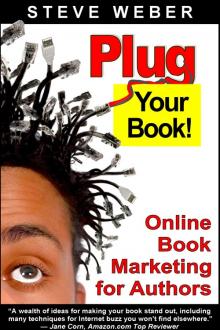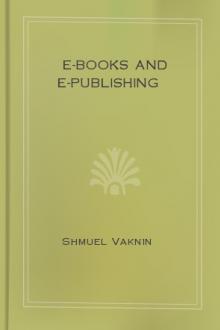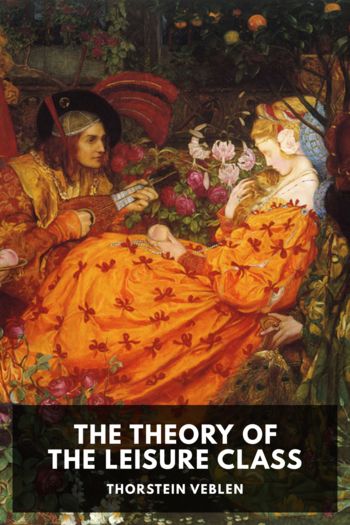Plug Your Book! by Steve Weber (books to read to be successful .txt) 📕

- Author: Steve Weber
- Performer: -
Book online «Plug Your Book! by Steve Weber (books to read to be successful .txt) 📕». Author Steve Weber
Like any valuable tool, tags can be abused, too. If tagging goes mainstream, spammers will try exploiting tags by adding their irrelevant tags to popular items.
Tags aren't necessarily linked with semantics. So the word "blow" could be used as a tag for wind, cocaine, sucking, breath, or a picture of a tornado, or the sound of air rushing. The user of the tag, not a search engine, decides how the meaning fits for them.
Advocates of tagging assert these fears are overblown. With enough users, tags become self-correcting, so inappropriate or useless tags will be drowned out by the good ones.
Whether it's Amazon, LibraryThing, or perhaps Google, whoever builds the biggest collection of tags will have an amazing insight into how people think about information, and will have a important tool for bookselling--the most detailed, current, and useful book index in history.
Advanced Amazon toolsWhile advertising is rarely a cost-effective marketing technique for books, online paid placement can be a useful tactic if it delivers your message to your target audience and delivers results. Since Amazon has such a large share of book buyers, it offers some of the best opportunities for showcasing your book.
Buy X, Get YYou can increase the odds of buyers finding your book by paying at least $750 a month to display it with a complementary book in Amazon's Buy X, Get Y program, known as BXGY. The primary benefit is your book's cover is prominently displayed on the detail page of a related book under the heading #Best Value#. Customers who buy both books get an additional 5 percent discount.
You'll pay more for a pairing with popular books. Amazon charges $1,000 a month for pairing with a book with a sales rank of 1 to 250, and $750 a month for pairing with slower-selling books.
An ideal BXGY campaign would pair your title with Amazon's No. 1 bestseller, so long as that bestseller appealed precisely to your audience. The stronger the Amazon Sales Rank of the paired title, the more people will see your promotion, and the more traffic will be redirected to your book's detail page. But if the paired title isn't relevant to your book, it won't work. Pairing your book with the latest installment of Harry Potter would bring a ton of exposure, but it wouldn't produce many sales, unless your book was aimed at the same readers.
You can find BXGY candidates by browsing Amazon's category bestseller lists and searching Amazon's book section for relevant keywords. Use the "Sort by" drop-down menu on the right to sift the books according to sales rank, publication date, and price. After browsing the search results, use Amazon's Search Inside the Book feature to get more information about the content of the titles. You can also browse for potential pairings at this Top Sellers link:
#www.Amazon.com/exec/obidos/ tg/new-for-you/#
#top-sellers/-/books#
Some publishers have tried pairing two of their own titles for BXGY, figuring it would boost sales of both books, but it doesn't. The main value of BXGY is sending readers to your book's detail page who might not find it otherwise. You can pair your title with only one other title at a time.
Publishers can participate in BXGY under Amazon's "small vendor" program if they have less than $1 million in annual sales on Amazon by applying at:
#www.Amazon.com/exec/obidos/ subst/misc/co-op/#
#small-vendor-faq.html#
Weaknesses of BXGYAmazon doesn't provide any figures on the success rates of BXGY promotions. Anecdotally, many publishers complain that while the program increases sales a bit, the revenue from those increased sales rarely covers the fees. However, BXGY is a tool some publishers use to spark initial word of mouth for a book, and in that sense it can be considered an investment. As discussed previously, increasing your sales on Amazon often leads to more success, bringing years of steady sales.
Often BXGY offers aren't compelling for buyers. Customers don't qualify for the program's 5 percent discount unless they purchase both the books new from Amazon; purchases of used copies don't count. For this reason, pairing your title with an older classic isn't effective if there's a plentiful supply of used or discounted copies. Buyers don't have much incentive to buy both books at full retail when they can get one deeply discounted.
Amazon offers more paid placement programs to large publishers, who can buy spots on Amazon's home page, category pages, and in specialized stores and seasonal lists such as "Back to School" or "Top Cookbooks of 2007." However, these placements aren't available under Amazon's Small Vendor program.
Free paired placement#You can get BXGY-like exposure without paying fees if your book sales are strong, relative to other titles in your category. Amazon pairs your book with a related title in a display nearly identical to BXGY's # Best Value #, but in this case it's called #Better Together#.
To see this in action, go to any book's detail page on Amazon. Under the heading #Better Together#, you'll see the book paired with another book, much like BXGY, albeit without the extra 5 percent discount.
If your book is the best-selling title in its niche, your book can appear on the Better-Together spot for several other related titles--another example of how strong sales on Amazon create more exposure for you.
Single New Product e-mails#Another Amazon placement opportunity is Single New Product e-mails, or SNPs. Amazon sends e-mails announcing your newly published title to customers who've purchased similar books or titles by certain authors.
Using a list of ISBNs suggested by the publisher, Amazon creates a pool of recipients who receive an e-mail highlighting your book, with links to buy it from the site. Amazon targets 5,000 to 10,000 recipients per mailing.
SNPs provide a unique marketing opportunity to publishers who don't have a large e-mail list of prospective book buyers they can advertise to. By contrast, most companies that offer e-mail lists for rental are used by spammers, and using their lists might result in more complaints than book sales.
The cost for small vendors with less than $1 million in annual sales on Amazon is $1,500 per title per SNP mailing. Titles are eligible for SNPs only during the 90 days following their publication date. To schedule SNPs, publishers must complete an SNP nomination form a few months before the publication date and commit to a certain month for the promotion.
Amazon ConnectIn 2006 Amazon launched its Connect feature, enabling authors to send blog posts directly to readers on Amazon's site. Your posts appear in several places--on your book's detail page, your Amazon profile--and buyers of your book receive an alert on Amazon's home page in a box called a plog.
Your Amazon Connect blog is a unique opportunity to communicate with new readers, and requires a different approach than you'd use with longtime readers on your own Web site. Visitors at your Amazon blog will include mostly first-time readers, who might feel as if they're butting into the middle of a conversation.
Your Amazon blog provides a great opportunity to introduce yourself to readers, says literary agent Matt Wagner, founder of Fresh Books:
Amazon Connect is your chance to stand next to your reader at the bookstore. The key is to be polite and not screw it up!
The key to writing an Amazon blog is not overdoing it. Understand that your readers are here to buy a book, not read a blog. This is not the place for long, drawn-out entries about your personal life or about the process of writing your next book. This is the place to put your book in context for readers who might be looking at your competition. A great place to start is: "Why I wrote this book."
Amazon Connect blogs also provide a way for you to stay in touch with readers who haven't yet committed to buying your book--or people who might be interested in your next book. Readers can subscribe to your Amazon blog in three ways:
Browsing the directory, # Amazon.com/gp/arms/directory#.
Clicking the yellow button labeled #Add to your Plog# from the Amazon Connect portion of your book's detail page.
Visiting your author Profile page and clicking Add posts to my plog in the blue box on the top right of the page.
You can also use your Amazon blog to refer visitors to your own Web site. Some authors do this by posting only the first paragraph of their post at Amazon, and asking readers to click through to their own site to continue reading.
You can get more information and apply for an Amazon blog here:
www.Amazon.com/ConnectAfter you apply for Amazon Connect, there's a verification procedure where your publisher or agent certifies you're actually the book author and are authorized to post materials about it on Amazon.
One fast way to add content to your Amazon Connect blog is by repurposing material you've already used at your own blog. However, if you use exactly the same material without much rewriting, Google and other search engines may flag the post as "duplicate content." More on that later.
ListmaniaListmania lists allow any Amazon user--readers, authors, music-lovers, movie buffs--to create lists of their favorite items organized by theme. Listmanias appear in various places on Amazon, like product detail pages and alongside search results. Listmanias that mention your book can expose your title to thousands of potential readers on Amazon, and can even appear in Google search results.
Listmanias are ranked by popularity among shoppers, based on viewership and the number of votes calling it "helpful." For example, one popular list is dedicated to novelist Nick Hornby, and was compiled by one of his fans. Under each novel is a pithy quote from the Listmania author, just enough to convey the gist of each book and why it appears. The list includes most of Hornby's books, other books Hornby edited or wrote introductions for, and a few other novels by writers with similar styles. See this list at:
#www.Amazon.com/gp/richpub/ listmania/fullview/#
#1X1GGDBXARHZ6#
See the 100 most popular Listmanias here:
#www.Amazon.com/gp/richpub/ listmania/toplists#
As an author, you're free to recommend books yourself with a Listmania list, mentioning up to 25 books in your list.
Niche books stand to gain the most from Listmanias. The more focused a Listmania is, the more helpful it is to buyers hungry for specific information--so the more likely it is to be noticed, read carefully, and acted on. Niche Listmanias have less competition--Amazon can show only so many "Harry Potter" Listmanias while the thousands of similar lists wait in a queue. But your Listmania about "Organic Strawberries" may pop up in front of every single customer looking for a relevant book.
To write a Listmania, click on the link at the bottom of your Amazon profile page, "More to Explore." Or start your list by clicking on the link Create Your Own List on an existing Listmania. Then:
Go to your Amazon Profile at: #www.Amazon.com/gp/pdp#.
Near the bottom of the middle column, in the section #More to Explore#, click Listmania Lists.
Click Create your first one now or Create another list.
Enter a title for your list and enter your "qualifications" such as "Avid reader" or "Book author." For your title, think of a blurb that will catch the eye of anyone shopping for a related book.
Enter ISBNs for the books for your list and a short comment





Comments (0)